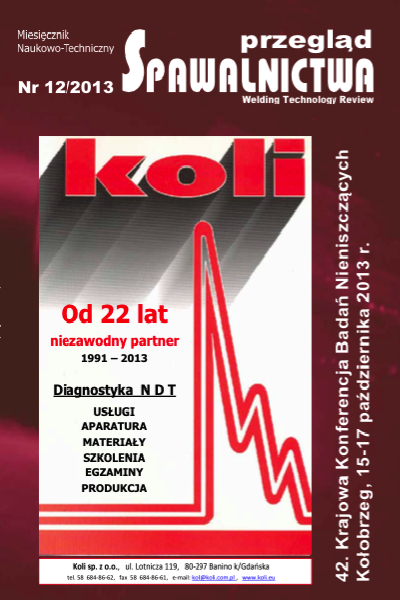Rozwój głowic piezoelektrycznych do pomiarów dwójłomności akustycznej
Main Article Content
Abstract
W artykule opisano rozwój głowic ultradźwiękowych do pomiarów dwójłomności akustycznej, budowanych od początku lat 70. ub.w. w Pracowni Badań Ultradźwiękowych prof. Juliana Deputata, a obecnie w Pracowni Badań nieniszczących Zakładu Wytrzymałości Materiałów IPPT PAn. W pracy omówiono różne zastosowania pomiarów dwójłomności akustycznej, a także przedstawiono historię rozwoju głowic wyposażonych w przetworniki piezoelektryczne. Opisane głowice budowane były głównie z myślą o pomiarach naprężeń własnych w wieńcach monoblokowych kół kolejowych. Przedstawiono różne układy przetworników, w jakie wyposażano kolejno głowice, oraz zalety i wady zbudowanych głowic.
Development of piezoelectric probeheads for acoustic birefringence measurements
Abstract
The paper describes the development of ultrasonic probeheads, built since 70-ties in Ultrasonic Testing Division lead by prof. Julian Deputat and than in nondestructive Testing Division IPPT PAN. Presented are applications of acoustic birefringence measurements and the history of development of probeheads equipped with piezoelectric transducers. Described are probeheads with various piezoelements configurations, designed mainly for residua stress evaluation in monoblock railroad wheels. Presented are advantages and disadvantages of various probeheads.
Downloads
Article Details
Creative Commons CC BY 4.0 https://creativecommons.org/licenses/by/4.0/
Welding Technology Review (WTR) articles are published open access under a CC BY licence (Creative Commons Attribution 4.0 International licence). The CC BY licence is the most open licence available and considered the industry 'gold standard' for open access; it is also preferred by many funders. This licence allows readers to copy and redistribute the material in any medium or format, and to alter, transform, or build upon the material, including for commercial use, providing the original author is credited.
References
Benson R., Realson V.G., Acoustoelasticity, Produkt Ingineering, nr. 29, 1959.
Rollins F.R., Study of Methods for non-destructive Measurement of Residua Stress, WADD Technical Report, Part I, 1959, s. 56-69.
Deputat J.: Własności i wykorzystanie zjawiska elastoakustycznego do pomiarów naprężeń własnych, Prace IPPT, nr 28/1987.
Jacquot T., Nogues M. and Hofmann U.: Residual stress analysis on heavy plates by ultrasonic testing Rev. Met. Paris, n°10 (October 2003), s.1023-1027
Mackiewicz S., Szelążek J., Gutkiewicz P.,: Ultradźwiękowe badania degradacji pełzaniowej stali stosowanych w energetyce, Mat. XIX Seminarium Szkoleniowego Badania nieniszczące, Zakopane, 12-15 marca 2013, s. 39-60.
Crecraft D.I.: Launching Ultrasonic Shear Waves in Solids a normal Incydent by Pressure Coupling, J. Sound Vibr., Vol. 4, 1964, s.381-387.
Crecraft D.I., The Measurement of Applied and Residual Stresses in Metals Rusing Ultrasonic Waves, J. Sound Vib., Vol 5 (I), 1967, s.173-192.
Effect of Frequent Braking on Residual Stress Field in the Wheel Rim, Office of Research and Experiments UIC, B-169 Report 2, Utrecht 1989.
Szelążek J.: Głowica ultradźwiękowa do pomiaru dwójłomności akustycznej, Patent nr PL 167941, 22 listopada 1995.
Schramm R.E., Szelążek J., Clark, Jr. A.V.: Dynamometer induced Residual Stress in Railroad Wheels: Ultrasonic and Saw Cut Measurements, nISTIR 5043, Report no. 30, National Institute of Standards and Technology, Boulder, March 1995.
